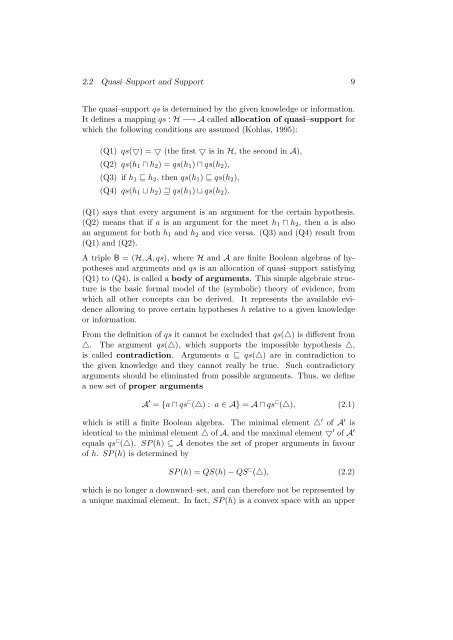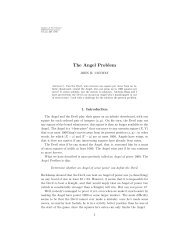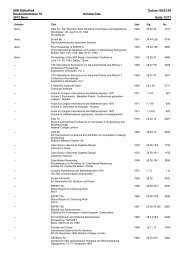Propositional Argumentation Systems and Symbolic Evidence Theory
Propositional Argumentation Systems and Symbolic Evidence Theory
Propositional Argumentation Systems and Symbolic Evidence Theory
You also want an ePaper? Increase the reach of your titles
YUMPU automatically turns print PDFs into web optimized ePapers that Google loves.
2.2 Quasi–Support <strong>and</strong> Support 9<br />
The quasi–support qs is determined by the given knowledge or information.<br />
It defines a mapping qs : H −→ A called allocation of quasi–support for<br />
which the following conditions are assumed (Kohlas, 1995):<br />
(Q1) qs(▽) = ▽ (the first ▽ is in H, the second in A),<br />
(Q2) qs(h 1 ⊓ h 2 ) = qs(h 1 ) ⊓ qs(h 2 ),<br />
(Q3) if h 1 ⊑ h 2 , then qs(h 1 ) ⊑ qs(h 2 ),<br />
(Q4) qs(h 1 ⊔ h 2 ) ⊒ qs(h 1 ) ⊔ qs(h 2 ).<br />
(Q1) says that every argument is an argument for the certain hypothesis.<br />
(Q2) means that if a is an argument for the meet h 1 ⊓ h 2 , then a is also<br />
an argument for both h 1 <strong>and</strong> h 2 <strong>and</strong> vice versa. (Q3) <strong>and</strong> (Q4) result from<br />
(Q1) <strong>and</strong> (Q2).<br />
A triple B = (H, A, qs), where H <strong>and</strong> A are finite Boolean algebras of hypotheses<br />
<strong>and</strong> arguments <strong>and</strong> qs is an allocation of quasi–support satisfying<br />
(Q1) to (Q4), is called a body of arguments. This simple algebraic structure<br />
is the basic formal model of the (symbolic) theory of evidence, from<br />
which all other concepts can be derived. It represents the available evidence<br />
allowing to prove certain hypotheses h relative to a given knowledge<br />
or information.<br />
From the definition of qs it cannot be excluded that qs(△) is different from<br />
△. The argument qs(△), which supports the impossible hypothesis △,<br />
is called contradiction. Arguments a ⊑ qs(△) are in contradiction to<br />
the given knowledge <strong>and</strong> they cannot really be true. Such contradictory<br />
arguments should be eliminated from possible arguments. Thus, we define<br />
a new set of proper arguments<br />
A ′ = {a ⊓ qs ❁ (△) : a ∈ A} = A ⊓ qs ❁ (△), (2.1)<br />
which is still a finite Boolean algebra. The minimal element △ ′ of A ′ is<br />
identical to the minimal element △ of A, <strong>and</strong> the maximal element ▽ ′ of A ′<br />
equals qs ❁ (△). SP (h) ⊆ A denotes the set of proper arguments in favour<br />
of h. SP (h) is determined by<br />
SP (h) = QS(h) − QS ❁ (△), (2.2)<br />
which is no longer a downward–set, <strong>and</strong> can therefore not be represented by<br />
a unique maximal element. In fact, SP (h) is a convex space with an upper








